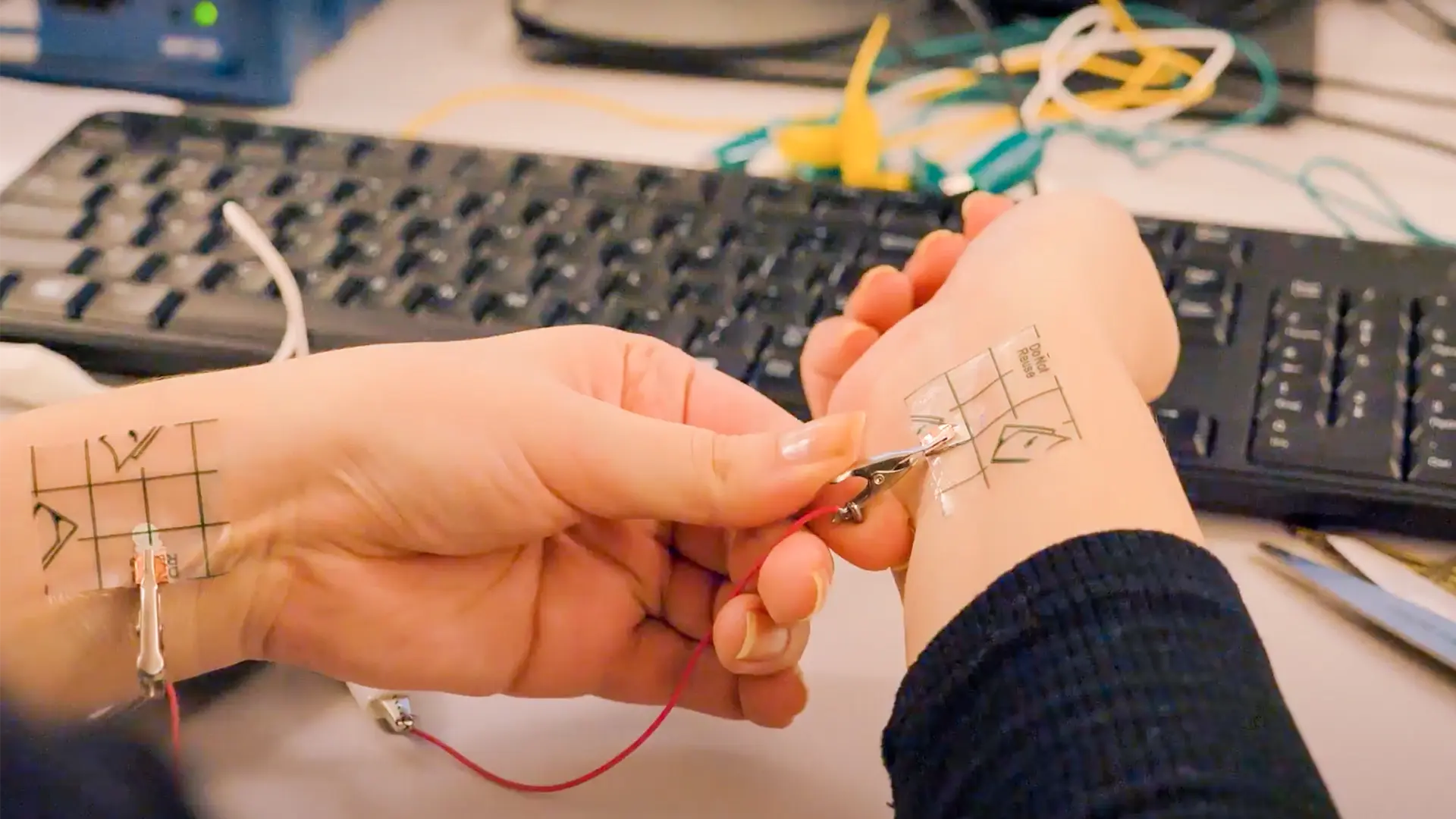What are Flexible Hybrid Electronics (FHE)?
There is a rising demand for smaller, thinner, and stretchable electronics to bring the innovations of tomorrow to life. In response, electronics manufacturing is adapting to meet these new requirements across industries. Flexible hybrid electronics (FHE), in particular, are notable for their capacity to bend and stretch without compromising the integrity of the electronic circuits, while enabling rapid prototyping.
What are flexible hybrid electronics?
Flexible hybrid electronics combine the best of printed and traditional electronics to create electronics that can bend, stretch, and conform to their environment. They are characterized by the combination of printed, conductive interconnects, flexible or stretchable substrates, and mounted components. This allows for devices that are not only lightweight and flexible, but also highly functional, enabling new applications in fields such as healthcare, consumer electronics, automotive, and beyond.
Printable and flexible hybrid electronics open new doors for industries that require flexible, biocompatible, conformable, and stretchable devices. With advancements in materials and manufacturing processes, FHE offers a tremendous impact for industries creating wearable devices, flexible displays, and even implantable electronics that can stretch with the body or adapt to irregular surfaces, among many others.
Key components of flexible hybrid electronics
The combination of flexible materials and rigid components makes flexible hybrid electronics unique from printed electronics or traditional rigid PCBs. FHEs integrate the advantages of flexible substrates with the robustness of conventional rigid electronic components and integrated circuits (IC), allowing researchers and engineers to customize electronics for their research, applications, and products.
Substrates for FHEs


What makes FHEs unique from other types of electronics is their use of substrates that are flexible and stretchable. Polyethylene terephthalate (PET) is commonly used for FHEs because it is cost-effective, durable, and flexible. However, thermoplastic polyurethane (TPU), polyimide (PI), BEYOLEX, and even novel substrates can offer different advantages, like biocompatibility or increased stretchability.
Some common substrate suppliers include (but are not limited to):
Conductors and interconnects for FHEs


Conductive inks are printed on flexible substrates to create electrical connections between components in FHEs. These inks are often flexible and/or stretchable to maintain conductivity, even when the substrate is bent, twisted, or stretched. Ink is printed via printing processes such as direct ink writing, inkjet printing, and aerosol printing. Direct ink writing, in particular, ensures that ink is only applied where it is needed which eliminates unnecessary material waste.
Some common ink suppliers for FHE include (but are not limited to):
Components for FHEs
Flexible hybrid electronics use traditional components such as silicon chips or resistors. Thinned silicon dies are often used in FHEs to make circuits smaller, lighter, and more adaptable to flexible applications. Components are mounted onto the printed conductive paths, forming the hybrid nature of FHEs. Components are often coated with an encapsulant like epoxy resins, silicone, or polyimide to protect against corrosion and contaminants, and help to reinforce components on the substrate when flexed.
Flexible hybrid electronics vs printed electronics vs flexible printed circuit boards
Other types of electronics are similar to flexible hybrid electronics, so you might be wondering, how do flexible hybrid electronics compare to printed electronics (PE) and flexible printed circuit boards (FPCB)? Each type is uniquely positioned to tackle different electronics applications, so understanding the differences is key to choosing the right solution for different projects.
Comparison of FHE vs PE vs FPCB
| Flexible hybrid electronics (FHE) | Printed electronics (PE) | Flexible printed circuit boards (FPCB) |
|---|---|---|
| Flexible/stretchable substrate | Flexible/stretchable substrate | Flexible (usually polyimide) substrate |
| Conductive ink (printed) | Conductive ink (printed) | Etched copper or laminated foil interconnects |
| Rigid components | Printed components | Rigid components |
| Limitation: Mechanical stress could cause material fatigue or dislodge components over time | Limitation: Still many years out from mass manufacturing fully printed electronics | Limitation: Requires subtractive manufacturing to create conductive traces, which wastes material and causes excess pollution |
| Advantage: Thinner and more flexible than traditional PCBs, low-cost for small production runs | Advantage: All elements are thin, flexible, and/or stretchable | Advantage: Utilizes existing PCB manufacturing lines for higher-value devices |
Future outlook for flexible hybrid electronics
Technological innovations are continually shaping the way industries approach electronics, and as a result, there is a growing demand for FHEs. According to IDTechEx, the flexible hybrid electronics market is projected to reach $1.8 billion USD by 2034.
The main industries positioned for growth in the flexible hybrid electronics market are:
- Bioelectronics: FHEs enable flexible, biocompatible devices like biosensors, electrodes, and wearable health monitors, improving personalized medicine and real-time patient care.
- Wearables: FHEs make smart devices, fitness trackers, and e-textiles lighter, more comfortable, and more durable.
- Printed batteries: FHEs support the development of lightweight, flexible printed batteries, creating energy storage solutions ideal for small, portable, and wearable devices.
- Antennas: FHE-based antennas enable high-performance, bendable communication systems for 5G, IoT devices, and compact wearables.
By merging the best features of printed electronics and traditional electronics, FHEs offer the versatility to meet the growing demand for smaller, thinner, and more flexible devices without compromising on performance or reliability. FHE technologies will drive the next wave of electronics, offering solutions that are functional, comfortable, and integrated seamlessly into everyday life.
Take a look at some of our in-house FHE projects:
- Printing Electroluminescent Ink on Paper and PET
- Printing a Flexible Membrane Keyboard with Conductive Silver Ink and Dielectric Ink on PET
Want the latest news in printed electronics? Subscribe to our newsletter. Meanwhile, if you have questions about your PCB printing needs, please contact us at sales@voltera.io or book a meeting.

Check out our Customer Stories
Take a closer look at what our customers are doing in the industry.


